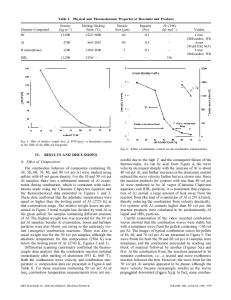Fabrication of near-net-shape Al 2 O 3 -fiber-reinforced Ni 3 Al composites by combustion synthesis
- PDF / 2,122,974 Bytes
- 10 Pages / 576 x 792 pts Page_size
- 10 Downloads / 342 Views
In this paper, a one-step, combustion synthesis-based process for fabricating A12O3 fiber-reinforced M3AI is described. The process uses relatively low temperatures and pressures, and can be used to prepare relatively large, dense, near-net-shape articles that possess either simple or relatively complicated shapes. This process can be used to incorporate continuous, aligned fibers into the Ni3Al matrix material in such a way that the fibers are not damaged either mechanically (due to relatively small loads applied during the process) or chemically (due to the very short time at which the sample remains at elevated tempertures during the process). (Chopped fibers, as well as equiaxed particles or whiskers, could also be similarly incorporated using this process.) This combustion synthesis process is a relatively simple one—requiring only relatively low temperatures and pressures, as well as relatively low-cost starting materials—which suggests that its scale-up beyond the laboratory scale would be particularly straightforward.
I. INTRODUCTION Nickel aluminides are considered to be important advanced materials, particularly for use in structural applications at elevated temperatures, because of their relatively low density, relatively high melting point, high thermal conductivity, and substantial resistance to oxidation and/or corrosion1"4 (see Table I). In the Ni-Al binary system (see Fig. 1), several ordered intermetallic compounds may be formed, of which Ni3Al is arguably the most attractive. Single-phase, monolithic N13A] is typically available in two forms: as (expensive) single-crystal monoliths, and as (less expensive) polycrystalline monoliths. Unfortunately, the so-called "room-temperature ductility" (i.e., brittleness at room temperature) and creep-resistance of single-phase, polycrystalline N13AI are qualities that limit the usefulness of this material; reinforcement of the material using the standard concepts and practices (see Table II) that are commonly used in the fabrication of composite materials can, however, be expected to improve both the room-temperature ductility and creep-resistance of the Ni3Al.5-14 TABLE I. Applications for NijAl-matrix composite materials. Pump impellers Dies/molds Kiln furniture Steam turbine applications National aerospace plane Electric heating elements Aircraft fasteners
1736 http://journals.cambridge.org
Radiant heaters Elevated-temperature springs Bearings Oil and gas well components Tool components Turbochargers Diesel engine components
J. Mater. Res., Vol. 10, No. 7, Jul 1995 Downloaded: 16 Mar 2015
The addition of reinforcements, such as ceramic whiskers or fibers, nearly always adds to the difficulty of preparing dense Ni3Al-matrix composites. First, the relative fragility of the ceramic reinforcements places limits on the magnitude of the mechanical pressure that may be used to produce dense composite materials. This, of course, suggests the use of an elevated-temperature process that allows the densification to be achieved using much lower pressures (as well
Data Loading...











